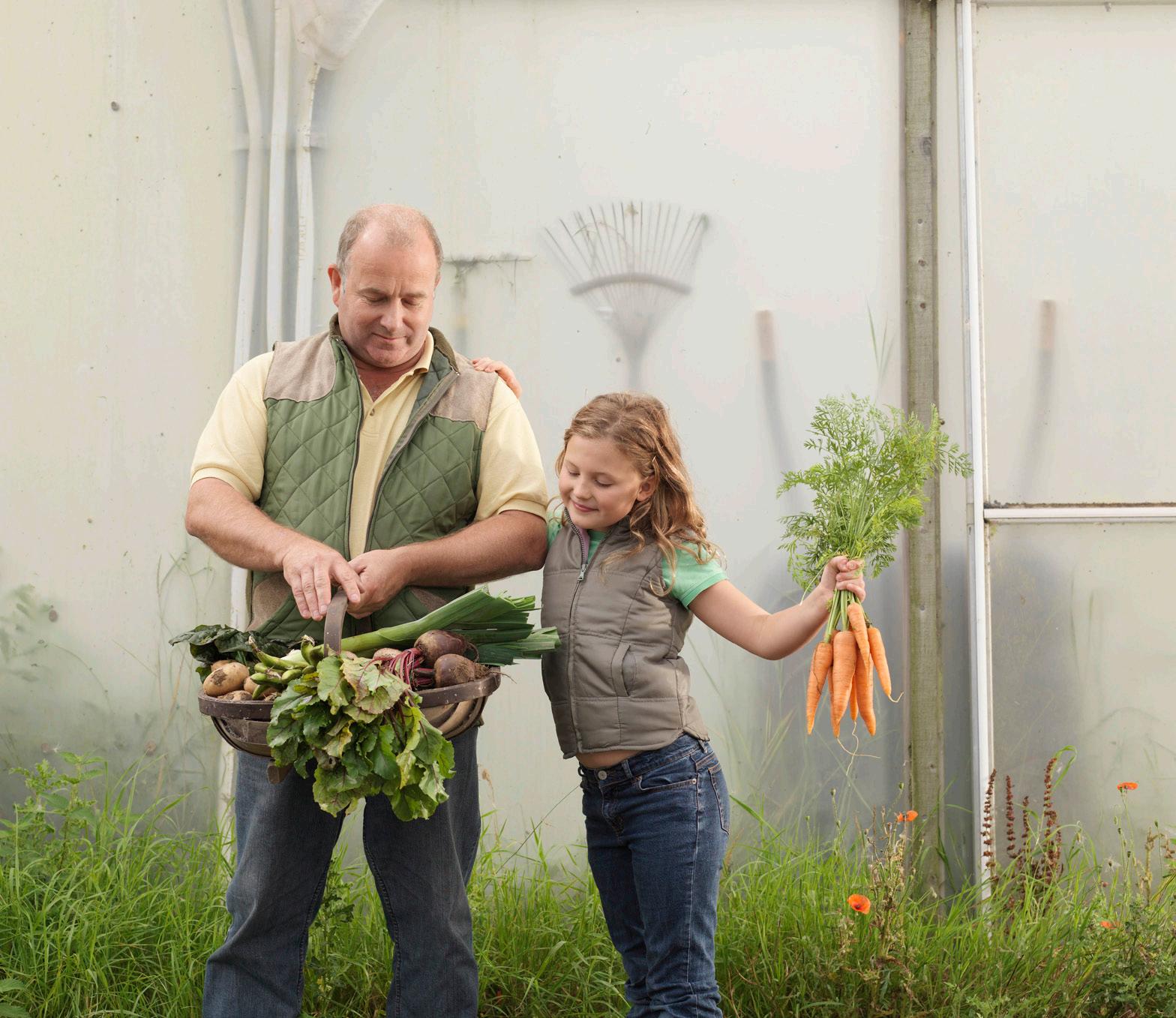FARM TO TABLE TO YOU









What exactly does this mean? Eating local means to purchase and consume produce and products from farmers and producers in your community and surrounding counties. There are many benefits to eating local. Not only is locally grown food healthier for you, but it also supports your community in a variety of great ways. Let’s learn just why eating local is so good for you.
Locally grown food is not imported from far away states or countries, like most foods you’d find in a supermarket. Instead, local food comes from farmers and producers right in your community, which means it doesn’t have to travel as far. As a result, local foods are often fresher and taste better than nonlocal foods. Fruits and vegetables from local farmers are often sweeter and juicier. The same thing goes for eggs that come from local chicken farmers. These eggs are usually fresher than those from other states, again because of less travel from farm to store. Of course, using fresh, local foods is not the only way to make enjoyable meals, but you’ll certainly notice a difference in the quality!
Foods like fruits and vegetables can lose some of their nutrients during transportation, processing and as they sit on shelves at the grocery store. As we’ve learned, locally grown produce does not have to travel far or sit in storage for too long. This means that local foods hold more of the nutrients our bodies need to stay healthy. It’s important to note that all types of fruits and vegetables — fresh or frozen, local or nonlocal — provide nutrients for our bodies. However, if your family has the chance to buy and eat locally grown foods, you’ll get more nutrition for the same (or less) amount of money.
If your family shops at farmers’ markets or a local food co-op, you’re likely to find new and unique foods that are grown in your area. Discovering these items is a great way to learn more about how food is grown in your community. By shopping local, you make connections with farms and producers, the very people who grow your food! Ask these farmers questions to learn about how your food is grown. These connections will help you develop a deeper appreciation for your food.
By supporting local farmers, you benefit the environment. Locally grown food is made available to you using less pollution and a lower carbon footprint. How? Because they’re close by, they require less transportation. This means sourcing local foods produces less pollution and fewer carbon emissions than nonlocal foods that require longer trips to the store.
Another way local foods protect our environment is that they lead to less waste. Local foods are typically sold at market stands without plastic packaging, and shoppers are encouraged to bring their own reusable bags. As a bonus, local produce does not need to undergo the same processing, which also eliminates plastic use and factory pollution. Overall, local food helps preserve our environment for generations to come.
Finally, by supporting local farmers, you’re maintaining farmland and green space in your area. Local farms that use sustainable practices promote clean air, water and soil, while protecting a wide variety of wildlife necessary to our ecosystems. Go green!
When your family buys local food, your money circulates back into your local economy. In fact, some studies suggest that revenue from local food sales contributes to increased employment and income within communities. These are all great benefits to eating locally grown foods!
If you want to eat more locally grown food, you’re in luck! Eating local is an easy thing to do. You can get started by visiting your local farmers’ market, eating at farm-to-table restaurants in your area or browsing the produce section at your grocery store for local products. Some stores add labels to local products. If you’re having a hard time finding some, ask the store’s produce manager to point you in the right direction.
Eating local benefits your health while supporting the farmers within your community. Local foods often taste fresher, offer more nutrients and use less plastic packaging. By eating locally grown foods, you’re also helping the environment and your local economy. Afterall, supporting local food businesses leads to strong community economies. It’s a win-win for everyone! Now, it’s time to get out there and plan your next trip to the farmers’ market. Have fun and eat local!







Did you help your parents manage your family garden this year with planting, watering, weeding, pest preventing, fertilizing or harvesting? Farmers do much of the same things but on a much larger scale and often with the help of technology. They provide their crops and livestock with all the necessary nutrients to grow, while protecting all from outside threats.
Farmers within Hancock County produce primarily food and consumable products. This includes row crops like corn and soybeans, livestock like beef and pork, and other crops like apples and Christmas trees. Additionally, many of Hancock County’s farms are diversified with multiple styles of farming.







CHOCOLATE MILK HAS BEEN NAMED THE OFFICIAL BEVERAGE OF HALLOWEEN 2021! WHY? BECAUSE IT IS NUTRITION IN DISGUISE!
The closest dairy farm to Greenfield is Estes Dairy Farm in Fountaintown run by husband-wife team Kerry and Christiana Estes. The Estes are first-generation dairy farmers who began in 2005. Their children, Damon and Laura, also help manage the farm’s calves, making it a true family business.
Most of the milk in your local grocery store or school cafeteria comes from within a 100-mile radius. Typically, milk goes from farm to store within 48 hours. That’s a quick trip to your table!
Ready for a sneak peek at getting it from cow to you?
It all begins with dairy farmers taking good care of their cows and ensuring they have the right amount of nutritious food, plenty of fresh, clean water and comfortable bedding and housing.
When it’s time to be milked, the cows enter the milking parlor. Dairy cows are milked mechanically two to three times a day. The machines help to milk up to 25 cows at a time and mimic a baby calf’s gentle action of sucking on the udder. This innovative milking technology has been in place on most U.S. farms since the 1920s.
The milk is collected at the same temperature as a cow’s body, about 100°F. The collected milk travels to a tank, where it is quickly cooled to 45°F or less to ensure quality and safety.
The fresh milk is then driven in an insulated, sealed tanker truck several times a day from the farm to a local dairy-processing plant. You’ve probably seen such a truck on the highway; it’s like a giant thermos on wheels!
Once the milk is unloaded from the tanker truck, it goes through several steps, including standardization, pasteurization, homogenization and quality testing. Additionally, milk may be fortified with vitamins A and D to boost its nutrition.
At this point, the milk is bottled before heading to your school or local store.
Indiana (and the car-racing world) has a very special, long-standing milk tradition in the slogan “Winners Drink Milk.” The tradition started at the Indianapolis 500, when driver Louis Meyer simply requested buttermilk to quench his thirst after his 1936 race. Now, milk is the iconic beverage every Indianapolis 500 winner drinks in the winner’s circle!
Are you ready for a tall, ice-cold glass of milk? The Indy 500 drivers can choose from fat-free, 2%, whole, buttermilk and chocolate.
WHICH WOULD YOU PICK?
A STANDARD 8-OZ. GLASS OF MILK PROVIDES
13 ESSENTIAL NUTRIENTS OUR BODIES NEED, MAKING IT ONE OF THE MOST NUTRIENT-DENSE FOODS.

FARM LIFE … WE LIVE IT, WE LOVE IT BY RIANNA AND SHERIDAN CHANEY
THE FARM THAT FEEDS US: A YEAR IN THE LIFE OF AN ORGANIC FARM BY NANCY CASTALDO
FARMER WILL ALLEN AND THE GROWING TABLE BY JACQUELINE BRIGGS MARTIN
THE MAGIC OF ME: MY MAGICAL FOODS BY BECKY CUMMINGS
ON THE FARM, AT THE MARKET BY G. BRIAN KARAS

• DRIED BEANS
• LIQUID SCHOOL GLUE
• MULTISURFACE ACRYLIC PAINT
As the leaves begin to change color and the air becomes crisp with an invigorating autumn breeze, it’s clear to see that fall has arrived. The changing of the seasons is the perfect time to search for inspiration for new
• PAPER PLATES
• PAINT BRUSHES
• PEN OR PENCIL
1. Plan your design. Using a pen or pencil, draw your design on a paper plate. This will serve as a guide for creating your art. Use simple shapes in your design, as they work best!
2. Fill in your design. Trace the edges of your design with glue and then fill it in. Working in sections will ensure fewer mess-ups when painting.
3. Glue your beans. Apply beans to the section you glued until each area is filled in. Let it dry completely. While you wait, feel free to start on more designs using other paper plates.
4. Paint your beans. Once the section is dry, it’s time to paint your beans. Use your desired colors and apply two coats if needed.

5. Repeat until done. Repeat steps 2-4 (design, glue, paint) until you’ve completed your masterpiece.
Great job! You just created your very own bean mosaic art. Now it’s time to put your new creations on display and enjoy!
When you know more about your health and how to take care of it, you can be more, do more and have more fun — starting now!